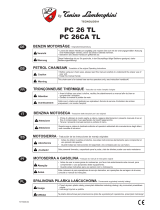
2500096_b 39
Safety instructions
■
Carry the chain saw at the front grip when
it is switched off, and have the saw chain
pointing away from your body. Always put
on the protective cover when transporting
or storing the chain saw. Careful handling
of the chain saw reduces the probability of in-
advertent contact with the running saw chain.
■
Follow the instructions for lubrication,
chain tensioning and changing accesso-
ries. An incorrectly tensioned or lubricated
chain can either tear or increase the risk of
kickback.
■
Keep the grips dry, clean and free from oil
and grease. Greasy, oily grips are slippery
and result in loss of control.
■
Only saw wood. Do not use the chain saw
for work for which it is not intended. Ex-
ample: Do not use the chain saw for saw-
ing plastic, masonry or construction ma-
terials that are not made of wood. Using
the chain saw for non-designated work can
lead to dangerous situations.
3.2 Causes and operator prevention of
kickback
Kickback can occur if the tip of the chain bar
touches an object or if the wood bends and traps
the saw chain during cutting.
In many cases, contact with the tip of the bar can
lead to an unexpected, rearward reaction causing
the chain bar to be knocked upwards and to-
wards the operator.
If the saw chain is trapped on the top edge of the
chain bar, the bar can be forced violently back to-
wards the operator.
Each of these reactions can result in you losing
control of the saw, with the possibility of severe
injury. Do not rely entirely on the safety devices
installed on the chain saw. As user of a chain
saw, you should take various measures to be
able to work without accident and injury.
Kickback is the consequence of incorrect or faulty
use of the tool. It can also be prevented by taking
suitable precautions as described below:
■
Hold the saw firmly with both hands, with
your thumb and fingers around the grips
of the chain saw. Hold your body and
arms in a position that allows you to with-
stand the kickback forces. If suitable mea-
sures are taken, the operator will be able to
control the kickback forces. Never release
the chain saw.
■
Avoid any abnormal posture, and do not
saw anything above shoulder height. This
will avoid inadvertent contact with the tip of
the bar, and allow better control of the chain
saw in unexpected situations.
■
Always use replacement bars and saw
chains prescribed by the manufacturer. In-
correct replacement bars and saw chains can
lead to the chain breaking and/or to kickback.
■
Comply with the instructions of the manu-
facturer for sharpening and maintaining
the saw chain. Depth limiters set too low in-
crease the tendency to kickback.
3.3 Safety information when working
■
Heed the country-specific safety regulations,
e.g. from the relevant trade associations, so-
cial security systems, authorities for industrial
safety.
■
Only work in sufficient daylight or artificial
lighting.
■
Keep the working area free from objects (e.g.
off-cuts) – danger of stumbling.
■
The user is responsible for accidents involv-
ing other people and their property.
3.3.1 Operator
■
Young people under 16 years of age and
people who do not know the operating in-
structions are not allowed to use the tool.
■
If you are working with a chain saw for the
first time: Have the salesperson or another
expert explain the operation of the chain saw,
or attend a course.
■
To operate the chain saw, you must be rest-
ed and in good physical and mental health. If
you must not exert yourself for health rea-
sons, ask your doctor whether it is possible to
work with a chain saw.
■
Take measures to protect yourself against
vibration loads. The actual vibration values
may differ from the values specified in the
technical data, depending on what the tool is
used for. In doing so, take account of the en-
tire working process, i.e. also times during
which the tool is operating without load, or is
switched off. Suitable measures include regu-
lar maintenance and care of the tool and the
tool attachments, keeping your hands warm,
taking regular breaks and planning the work-
ing sequences effectively.




















